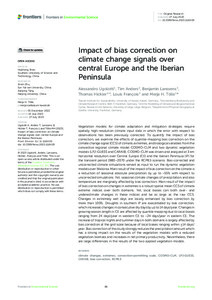| dc.date.accessioned | 2023-08-22T14:39:06Z | |
| dc.date.available | 2023-08-22T14:39:06Z | |
| dc.date.issued | 2023-07-27 | |
| dc.identifier | doi:10.17170/kobra-202308228662 | |
| dc.identifier.uri | http://hdl.handle.net/123456789/15017 | |
| dc.description.sponsorship | Gefördert durch den Publikationsfonds der Universität Kassel | |
| dc.language.iso | eng | |
| dc.rights | Namensnennung 4.0 International | * |
| dc.rights.uri | http://creativecommons.org/licenses/by/4.0/ | * |
| dc.subject | climate changes | eng |
| dc.subject | extremes | eng |
| dc.subject | convection-permitting scale | eng |
| dc.subject | COSMO-CLM | eng |
| dc.subject | LPJ-GUESS | eng |
| dc.subject | CARAIB | eng |
| dc.subject | bias correction | eng |
| dc.subject | RCP8.5 | eng |
| dc.subject.ddc | 500 | |
| dc.subject.ddc | 530 | |
| dc.title | Impact of bias correction on climate change signals over central Europe and the Iberian Peninsula | eng |
| dc.type | Aufsatz | |
| dcterms.abstract | Vegetation models for climate adaptation and mitigation strategies require spatially high-resolution climate input data in which the error with respect to observations has been previously corrected. To quantify the impact of bias correction, we examine the effects of quantile-mapping bias correction on the climate change signal (CCS) of climate, extremes, and biological variables from the convective regional climate model COSMO-CLM and two dynamic vegetation models (LPJ-GUESS and CARAIB). COSMO-CLM was driven and analyzed at 3 km horizontal resolution over Central Europe (CE) and the Iberian Peninsula (IP) for the transient period 1980–2070 under the RCP8.5 scenario. Bias-corrected and uncorrected climate simulations served as input to run the dynamic vegetation models over Wallonia. Main result of the impact of bias correction on the climate is a reduction of seasonal absolute precipitation by up to −55% with respect to uncorrected simulations. Yet, seasonal climate changes of precipitation and also temperature are marginally affected by bias correction. Main result of the impact of bias correction on changes in extremes is a robust spatial mean CCS of climate extreme indices over both domains. Yet, local biases can both over- and underestimate changes in these indices and be as large as the raw CCS. Changes in extremely wet days are locally enhanced by bias correction by more than 100%. Droughts in southern IP are exacerbated by bias correction, which increases changes in consecutive dry days by up to 14 days/year. Changes in growing season length in CE are affected by quantile mapping due to local biases ranging from 24 days/year in western CE to −24 days/year in eastern CE. The increase of tropical nights and summer days in both domains is largely affected by bias correction at the grid scale because of local biases ranging within ±14 days/ year. Bias correction of this study strongly reduces the precipitation amount which has a strong impact on the results of the vegetation models with a reduced vegetation biomass and increases in net primary productivity. Nevertheless, there are large differences in the results of the two applied vegetation models. | eng |
| dcterms.accessRights | open access | |
| dcterms.creator | Ugolotti, Alessandro | |
| dcterms.creator | Anders, Tim | |
| dcterms.creator | Lanssens, Benjamin | |
| dcterms.creator | Hickler, Thomas | |
| dcterms.creator | François, Louis | |
| dcterms.creator | Tölle, Merja Helena | |
| dcterms.extent | 26 Seiten | |
| dc.relation.doi | doi:10.3389/fenvs.2023.1116429 | |
| dc.subject.swd | Klimaänderung | ger |
| dc.subject.swd | Konvektion | ger |
| dc.subject.swd | Messfehler | ger |
| dc.type.version | publishedVersion | |
| dcterms.source.identifier | eissn:2296-665X | |
| dcterms.source.journal | Frontiers in Environmental Science | eng |
| dcterms.source.volume | Volume 11 | |
| kup.iskup | false | |
| dcterms.source.articlenumber | 1116429 | |


